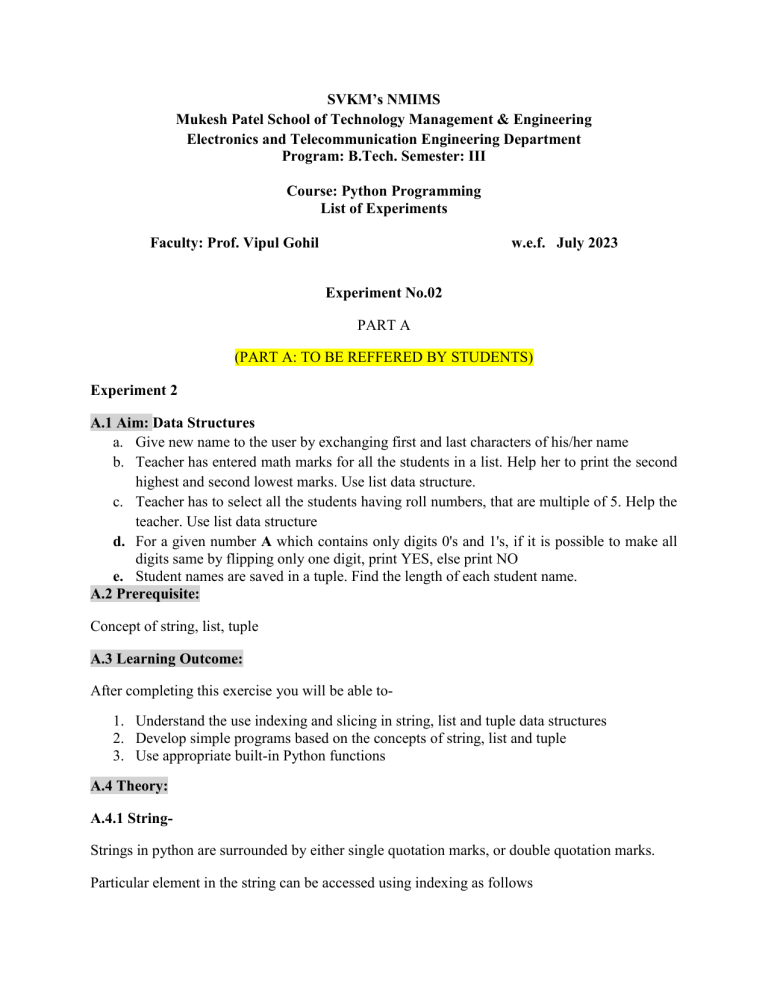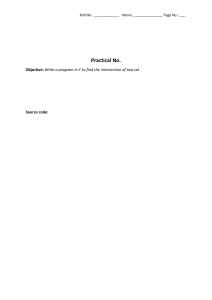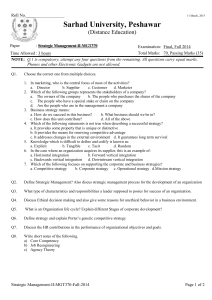
SVKM’s NMIMS Mukesh Patel School of Technology Management & Engineering Electronics and Telecommunication Engineering Department Program: B.Tech. Semester: III Course: Python Programming List of Experiments Faculty: Prof. Vipul Gohil w.e.f. July 2023 Experiment No.02 PART A (PART A: TO BE REFFERED BY STUDENTS) Experiment 2 A.1 Aim: Data Structures a. Give new name to the user by exchanging first and last characters of his/her name b. Teacher has entered math marks for all the students in a list. Help her to print the second highest and second lowest marks. Use list data structure. c. Teacher has to select all the students having roll numbers, that are multiple of 5. Help the teacher. Use list data structure d. For a given number A which contains only digits 0's and 1's, if it is possible to make all digits same by flipping only one digit, print YES, else print NO e. Student names are saved in a tuple. Find the length of each student name. A.2 Prerequisite: Concept of string, list, tuple A.3 Learning Outcome: After completing this exercise you will be able to1. Understand the use indexing and slicing in string, list and tuple data structures 2. Develop simple programs based on the concepts of string, list and tuple 3. Use appropriate built-in Python functions A.4 Theory: A.4.1 StringStrings in python are surrounded by either single quotation marks, or double quotation marks. Particular element in the string can be accessed using indexing as follows str1= “Hello” print(str1[2]) Slicing Specify the start index and the end index, separated by a colon, to return a part of the string. b= "Hello,World!" print(b[2:5]) String concatenation To concatenate, or combine, two strings you can use the + operator. a= "Hello" b= "World" c=a+b print(c) A.4.2 Lists Lists are used to store multiple items in a single variable. Lists are one of 4 built-in data types in Python used to store collections of data, the other 3 are Tuple, Set and Dictionary. Lists are created using square brackets Create list Fruit_list = ["apple", "banana", "cherry"] print(Fruit_list) List length To determine how many items a list has, use the len() function: A list can contain different data types list1 = ["abc", 34, True, 40, "male"] Access Items thislist=["apple", "banana", "cherry"] print(thislist[1]) List slicing thislist = print(thislist[2:5]) ["apple", "banana", "cherry", "orange", "kiwi", "melon", "mango"] Append Items thislist = ["apple", "banana", "cherry"] thislist.append("orange") print(thislist) A.4.3 TuplesTuples are used to store multiple items in a single variable A tuple is a collection which is ordered and unchangeable. Tuples are written with round brackets. thistuple=("apple", "banana", "cherry") print(thistuple) A tuple can contain different data types. tuple1 = ("abc", 34, True, 40, "male") A.5 Task to be completed: a. Give new name to the user by exchanging first and last characters of his/her name b. Teacher has entered test marks for all the students in a list. Help her to sort the list and also find out the second highest marks. c. Create a list of Roll Numbers and find out: i) Roll numbers which are multiples of 3 ii) Roll numbers which are divisible by 3 *************************************************************************** PART B (PART B: TO BE COMPLETED BY STUDENTS) (Students must submit the soft copy as per following segments within two hours of the practical. The soft copy must be uploaded on the MS Teams assignment link at the end of the practical) Roll No. D030 Program : B. TECH - EXTC Batch: D2 Date of Submission: 24th July, 2022 Name: HITARTH SHETH Division: D Date of Experiment: 19th July, 2022 Grade : B.1 Tasks given in PART A to be completed here (Students must write the answers of the task(s) given in the PART A /Students must copy the code, output screenshots here based on the task(s) given in section A.5) a) Give new name to the user by exchanging first and last characters of his/her name b) Teacher has entered test marks for all the students in a list. Help her to sort the list and also find out the second highest marks. c) Create a list of Roll Numbers and find out: i) Roll numbers which are multiples of 3 ii) Roll numbers which are divisible by 3 B.2 Observations and Learning: (Students must write the observations and learning based on their understanding built about the subject matter and inferences drawn) In this experiment, I learnt about usage of lists and strings in Python. They’re useful for storing multiple data items and provide a comprehensive way of accessing them. B.3 Conclusion: (Students must write the conclusive statements as per the actual attainment of individual outcomes listed above and learning/observation noted in section B.2) Through this experiment, after understanding the working of lists and strings, we can develop simple programs based on these concepts which also make use of in-built functions such as sorting, to sort a list. B.4 Question of curiosity: (This section aims to develop student’s curiosity, research ability. So students are free to search the answer on web. This section includes general .case study based/out of syllabus questions based on the theme of the experiment. Students should be able to answer these questions based the experiment carried out.) 1. What will be the output of following program? numbers = [1, 2, 3, 4] numbers.append([5,6,7,8]) print(len(numbers)) 4 5 8 12 Ans: 5 2. What will be displayed by the following code? list1 = [1, 3] list2 = list1 list1[0] = 4 print(list2) [4,3] [1,3] [1,4] [1,2,3] Ans: [4,3] 3. What will be the output of the following code? Write your answer str1="Investigator" print(str1[2:8]) Ans: vestig ***************




